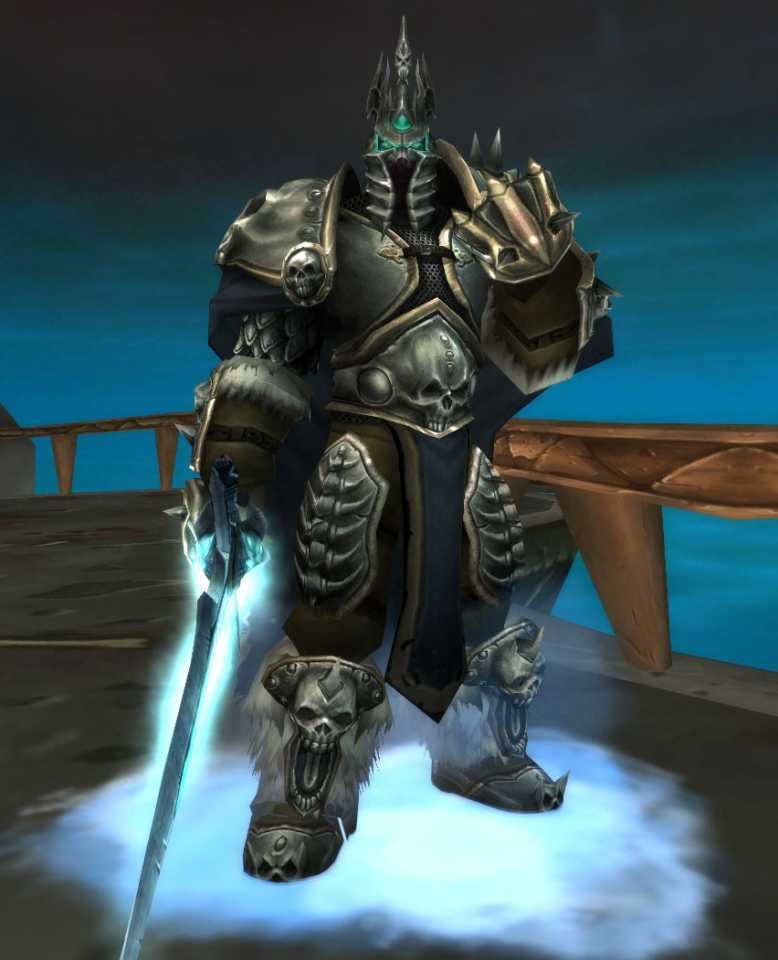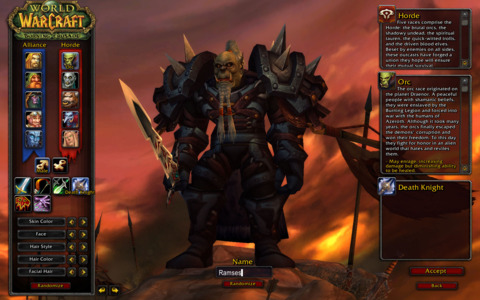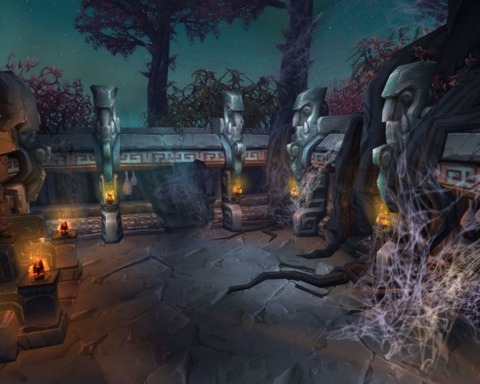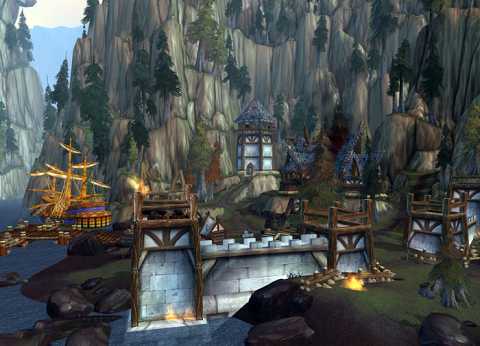[EDITOR'S NOTE] When we decided that we wanted to cover Wrath of the Lich King, we determined that an expansion review like this one would only really be useful to people who are still playing World of Warcraft--or people who played a lot of it and stopped, but might be interested in coming back. Since the four of us haven't played World of Warcraft in ages, we decided to enlist the assistance of the upstairs technical crew. Andy McCurdy has been playing World of Warcraft since the beginning with no serious breaks, so we figured he'd be the best guy to figure out if the new stuff Blizzard added is worth your time.
Give or take, Wrath of the Lich King marks World of Warcraft's fourth birthday. Think back to what you were doing in 2004. You were probably into the Xbox or PlayStation 2, and perhaps you were really excited about that Halo sequel that all the kids were playing. Maybe you were a little ahead of the curve and were waiting patiently for God of War, which would ship the following Spring. Point being, it's been a long time since World of Warcraft's initial release. But over those four years, Warcraft has changed. It's almost turned into a platform unto itself, with the kind of monthly improvements that other MMO developers have often talked about but never get around to implementing. But Blizzard's good ideas have a way of actually making it into their game, a trend that continues with this latest expansion. Wrath of the Lich King implements a mess of cool improvements, pushing the game forward and further cementing World of Warcraft's place at the very top of the genre.
Give or take, Wrath of the Lich King marks World of Warcraft's fourth birthday. Think back to what you were doing in 2004. You were probably into the Xbox or PlayStation 2, and perhaps you were really excited about that Halo sequel that all the kids were playing. Maybe you were a little ahead of the curve and were waiting patiently for God of War, which would ship the following Spring. Point being, it's been a long time since World of Warcraft's initial release. But over those four years, Warcraft has changed. It's almost turned into a platform unto itself, with the kind of monthly improvements that other MMO developers have often talked about but never get around to implementing. But Blizzard's good ideas have a way of actually making it into their game, a trend that continues with this latest expansion. Wrath of the Lich King implements a mess of cool improvements, pushing the game forward and further cementing World of Warcraft's place at the very top of the genre.

One of the most exciting elements of Lich King's quests is that some them give you the feeling that you're actually changing pieces of the landscape. One quest produces an in-game cinematic of an epic fight with the Scourge, the fall of an Alliance hero, and the devastation of a town. From then on, players who have completed this quest see the area as completely devastated from the battle, while others continue to see the land whole, as it was previous to the encounter. This epic feeling of taking part in larger world events continues as you fight alongside notable computer-controlled faction leaders, rampaging and invading a player-controlled town. This is a key point--Lich King actually makes you care about the fates of the world's NPCs by having you fight alongside them against other human players. These NPCs are further fleshed out and made meaningful via some terrific voice acting from key characters in the more-meaningful quests. These elements add a lot of character to the experience.
Wrath of the Lich King also adds World of Warcraft's first new class, the Death Knight. Denoted as a "hero class," you can only create a Death Knight if you have a character that is already level 55. Death Knights start at level 55 and come equipped with a full set of rare gear. While forcing players to have a level 55 character establishes a decent barrier to entry, it hasn't completely stopped the "new-class-itis" that typically infects an MMO when a new character class is added to the game. Expect to see a lot of DKs running around until the newness factor wears off.

As far as abilities are concerned, Death Knights focus their power through runes which are embedded onto their weapons. There are three types of runes: Blood, Frost and Unholy. Each of these match up to a corresponding talent tree. Death Knights have two of each rune type, which are consumed by their special abilities. For example, the Death Strike ability costs one Unholy rune and one Frost rune. Runes restore their power 10 seconds after being used, so playing a Death Knight requires some micromanagement of which abilities you want to use in which order. Given that only seasoned players can even create a Death Knight, this setup is a skill-based way to make the class fun and unique.
Inscription is the new profession featured in Wrath of the Lich King. Inscribers can create glyphs that enhance the skills and spells of other players. Each player can have three major and three minor glyphs. Major glyphs enhance a skill or spell by increasing its potency, such as increasing the damage it causes, the healing it does, or the duration of the effect. Minor glyphs add smaller gains to less-used spells, or provide novelty effects to existing abilities. Mages with the minor glyph of polymorph, for example, will now transform their target into a penguin instead of a sheep.
Blizzard has overhauled the other professions quite a bit, providing a direct benefit to the players who've leveled up their professions. For example, enchanters receive item enhancements that can be used only on their items, and blacksmiths receive the ability to add sockets to their existing armor. Even gathering professions have benefited from these changes. Miners receive a buff to hit points for all the sweat they've put in, herbalists receive an area-of-effect healing wave where flowers grow from the ground, and experienced skinners receive an added chance to critically strike opponents in combat.

The game also introduces some other fun, just-for-kicks additions, like a barber shop where you can change your hair style, hair color, and facial hair. Tired of your old look? Have a hair color that doesn't go with your cool new gear? No worries, just fork over 10 gold for a whole new look. Oh yeah, and getting a haircut is an achievement, too. Just like real life!
As usual, Blizzard has absorbed some player-made tools and interface mods and made those concepts official parts of the game client. With Wrath, players now have access to a calendaring system to keep track of special events and gatherings. That might sound silly to a less-serious player, but if you've been playing World of Warcraft long enough to get this deep into the game, you probably understand how important it can be to stay organized with your posse. This calendar is available both in-game and on the WOW website, which is handy.
Generally speaking, a lot of the changes that have been made in Wrath are great at making the game more accessible. You can tell that Blizzard learned a lot from the release of the previous expansion, The Burning Crusade. For example, BC had all the players funnel to one starting zone to begin their climb to level 70. This caused big bottlenecks and made some quests hard to complete because two million other adventurers were trying to do the exact same thing during the first few weeks of release. Wrath provides two starting areas for players in the new area of Northrend, and the areas have a lot of different branches that give you different ways to get up to level 80. Also, access to Northrend has been made very apparent with a boat that leaves from Azeroth's major cities, rather than having players quest out to the little-visited Blasted Lands to teleport to the new areas, as in Burning Crusade.

The new dungeons also seem to have been designed with accessibility in mind, with shorter lengths in lots of the leveling instances. In these new areas, it's not uncommon to blaze through a five-man dungeon in under 30 minutes. That may not sound like a good thing, initially, but since it lets you see the more-interesting boss fights more frequently, it's actually a very good thing. Late-game raids in Wrath can be run in 10- or 25-player mode. This is cool because it lets players who might not be in a large, organized guild still have a chance at seeing some content that they might not be able to see otherwise. Both versions offer the same content, but the 25-man version offers slightly better loot. This change is great for casual players while still giving the hardcore guilds an incentive by making the top-tier loot exclusively available to the players who are organized enough to play with 25-man groups.
Player-versus-player combat is still a major part of World of Warcraft in this expansion. Players have new abilities to access in PVP battles, and Wrath adds an additional multiplayer battleground called Strand of the Agents. Strand puts one team on offense and the other on defense and opens with the offensive team making a Normandy-style beach landing, followed by an attack on the town gates of a city that the defenders must keep safe. Players can drive battering ram vehicles to knock down walls, but must also be careful of artillery mounted on the city walls. After the offense captures the city or time runs out, the factions swap sides.

While what's in the box and on the servers is great, it's not quite as much as was originally promised for the expansion. Several raids, including an epic battle with Arthas himself, aren't available at the time of this writing, and are scheduled to appear in an upcoming content patch. Also, promised features like dual specs, which will allow players to flip between two sets of talent configurations on the fly, haven't made it in yet.
But it's hard to complain too much about minor omissions like those when the current content in Wrath of the Lich King is so broad and so solid. This package makes for an epic and excellent expansion to World of Warcraft, one that will certainly keep longtime players coming back. And the increased accessibility and streamlined nature of World of Warcraft 2008 compared to World of Warcraft 2004 mean that even players who gave up a long time ago will also find plenty of reasons to return to Azeroth.